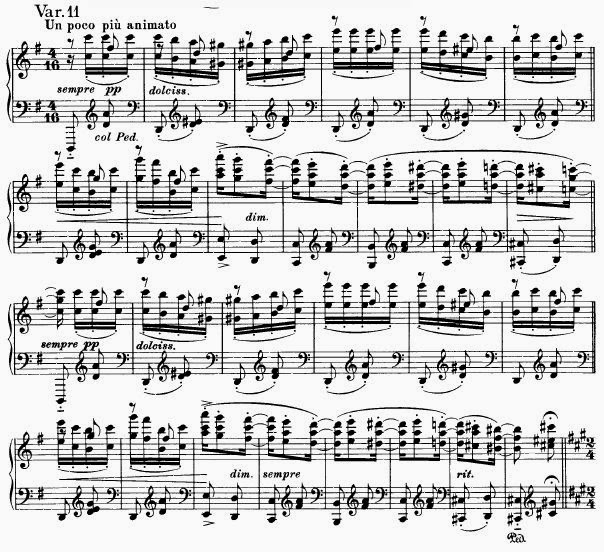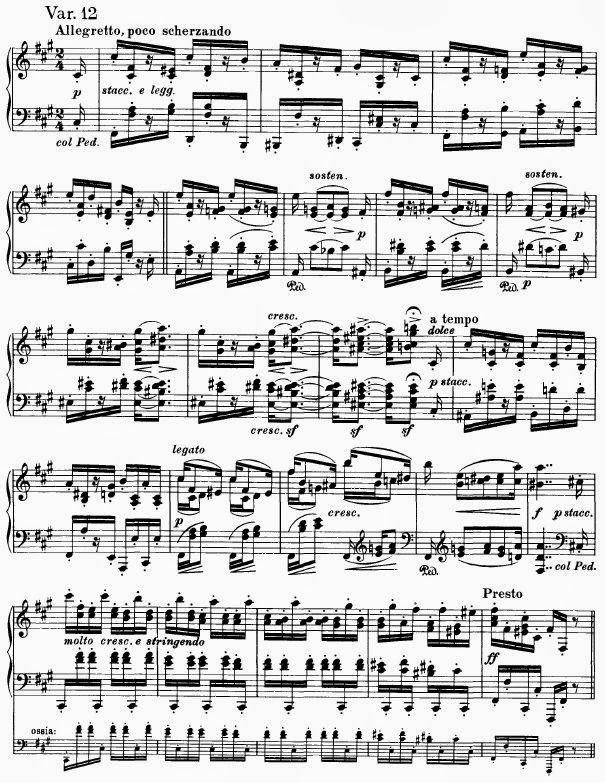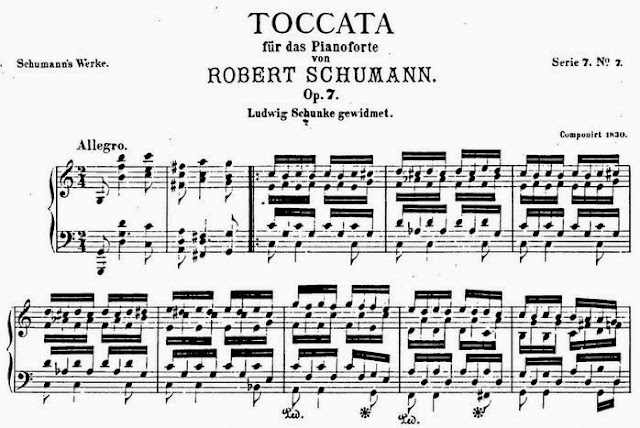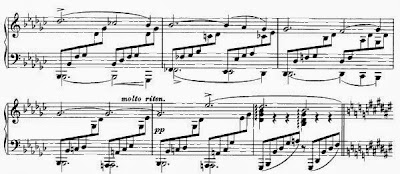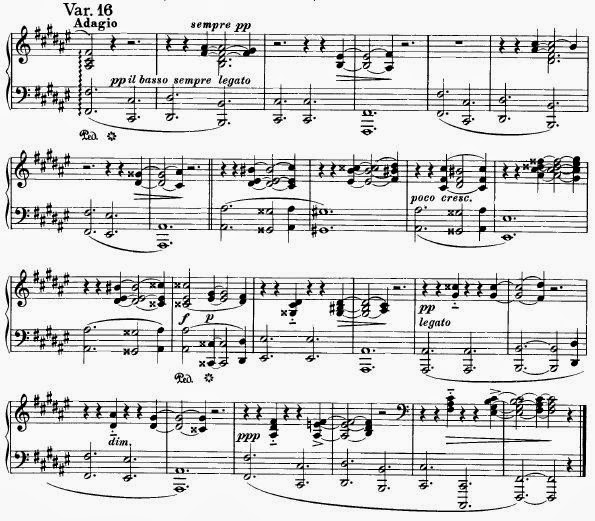Un poco piu animato
4/16 time
Variation 11, marked sempre pp and dolciss., is light, quiet, and mysterious. The right hand plays high octaves in sixteenth notes, beginning with repeated Cs, moving down by steps, then up by steps. The bass begins each bar with a low D in an eighth note that is repeated through most of the piece, followed by a two-note chord. The first half ends with three-note chords in the right hand, syncopated, accompanied by quarter-note octaves in the bass. The second half is an exact repeat of the first half, although ending with slightly altered different chords.
Thursday, October 31, 2013
Wednesday, October 30, 2013
Variation 12
Allegretto, poco scherzando
2/4 time
2/4 time
This jerky, scherzo-like variation with its wildly accelerating close, is the only fast and lively piece after Variation 6. It returns us to the key of F-sharp minor, after Variations 9-11 have taken us away.
In bars 1-4 the top notes in the right hand clearly play the theme, but the rhythm is very unbalanced. Each bar plays sixteenth notes in two groups, but with a rest replacing the third note, possibly an allusion to Schumann's "Fabel" from his Fantasiestücke, Op. 12 (see below). The bass constantly leaps from low to high.
The middle section rises in three steps toward a climax, but each time is interrupted and pauses, suddenly switching from sixteenth to eighth notes marked sostenuto. The third pause is more pronounced, extended from one bar to two bars, marked with a with a crescendo, each of three thick climactic chords marked sfozando, and a marked pause on the last note. After a return to another quiet version of the opening pattern, there is a rise to yet another climax.
The piece ends with a five-bar coda, increasing in speed and volume. A cross-rhythm is created by emphasizing every third note. In the final two bars the molto crescendo e stringendo acceleration is increased by emphasizing every second note. The final bar, leaping downward for a highly dramatic close, is marked presto.
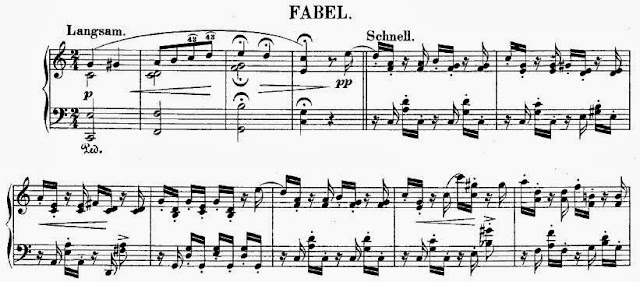 |
| Schumann’s Fantasiestücke, Op. 12, "Fabel" |
Tuesday, October 29, 2013
Variation 13
Non troppo Presto
2/4 time
2/4 time
Light and delicate, Variation 13 flutters in the higher registers like a butterfly.
The first four bars are repeated. This is the only place in the set where there is a repeat sign.
Variation 13 resembles Schumann's powerful Tocccata, Op. 7 in its figuration, if not in its character.
Monday, October 28, 2013
Variation 14
Andante
3/8 time
 |
| Brahms, Variations on a Theme by Schumann, Op. 9, Variation 14 |
Variation 14 is another canon, as were nos. 8, 10, and 15. The following voice is two bars behind the leading voice and one step higher ("canon in seconds"). Both voices are in the right hand. The left hand accompanies with arpeggios that cover two bars and rise and fall more than two octaves.
Pianist David Korevaar describes Variation 14 as "worthy of Bach’s Goldberg Variations" and "carried out in a way redolent of Schubertian melancholy."[1]
Variation 14 resembles the "Chopin" section of Schumann's Carnaval, Op. 9.
______________________________________________________________________
1. David Korevaar, Liner notes, Brahms Variations, Ivory Classics.
Sunday, October 27, 2013
Variation 15
Notated in G-flat, Variation 15 returns to the home key of F-sharp minor.
Like the preceding Variation 14, there is a beautiful melody in the right hand with an accompaniment of arpeggios in the left hand that continue throughout. This time the arpeggios only rise, without the rise-and-fall of Variation 14.
In yet another canon the right-hand melody is followed in the left-hand at a distance of one bar and an interval of a sixth ("canon in sixths").
Variation 15 seems to make reference to an Impromptu by Schubert (Op. 90, No. 2), a composer much beloved by Robert Schumann, and it may allude to the opening section of Schumann’s Humoreske.
Saturday, October 26, 2013
Variation 16
Adagio
6/4 time
Variation 16 continues without pause from Variation 15. There is nothing climactic about this final variation which is very slow and very simple, consisting mainly of prolonged octaves in the bass in dotted half notes and dotted whole notes. The melody line of Schumann's theme is, surprisingly, not used, replaced by the bass octaves echoing of the lush melody of Variation 10, which in turn originated in the bass line of Schumann's theme. The effect is deeply contemplative, perhaps elegiac.
Subscribe to:
Posts (Atom)
